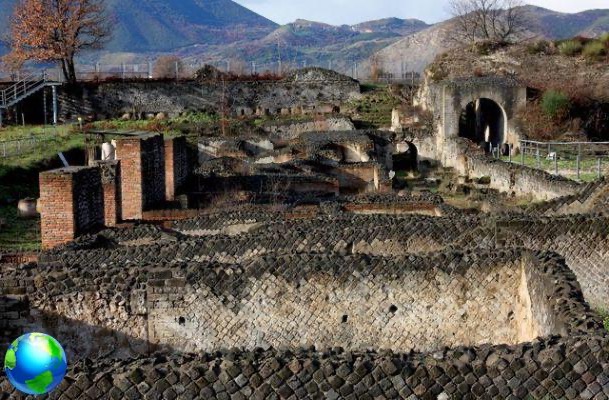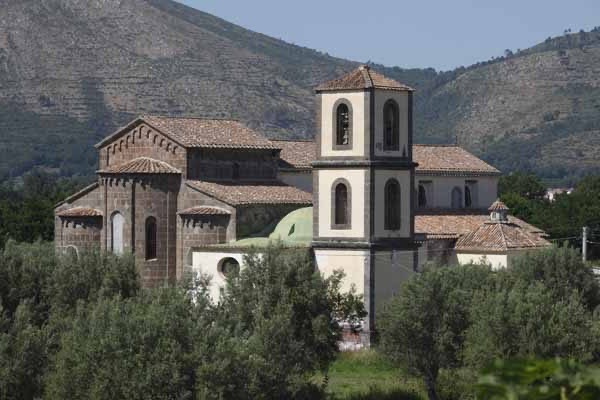Calvi Risorta in Caserta, an area of Campania to be discovered for its archaeological areas and its pastry shops, come and read the advice in the post.
We travel a lot. Airplanes and express trains are shortening more and more distances that until not too many years ago seemed oceanic. As soon as we have a few hours we grind kilometers and kilometers of roads in search of villages, typicality, other than us. Looking too far, we too often forget to look down on our surroundings. Beauty is everywhere, and it is closer than we imagine. I myself have made this mistake too many times. I wrote about St. Petersburg, Prague, Turin, Cadiz. Sometimes I've narrowed the circle and moved to Atina and then to Naples, Santa Maria Capua Vetere, even. Without realizing that the beauty, the history, the wealth I had inside the house, under the house.
Well, today I'm talking to you about me to tell you about my country: Calvi Risorta.

It is located in the upper Caserta area, about thirty kilometers from Caserta and less than ten kilometers from Teano (place of the historic meeting between Garibaldi and Vittorio Emanuele).
Coming from the main crossroads, you will find a sign announcing that you have reached “Calvi Risorta, formerly Cales”. Yes, because my country, which today has about six thousand inhabitants, has risen precisely on the ruins of the Ancient Cales, in which the Aurunci, the Ausoni, the Etruscans, the Latins and the Samnites have left their footprints.
“Caleno” is the noun adjective that identifies us as inhabitants of.
And caleni were the "Fictilia", that is the clay vases that were produced here, such as calene were the famous glazed pottery in glossy black paint, distributed throughout Italy.
Good wine produced there led Cicero to speak of Agro Caleno referring to my country and, even today, there are many farmers dedicated to the care of the vineyard.
Vitruvius, Horace, Cato, Juvenal, Virgil and many others also quote us in their verses with words of praise and appreciation.
How many times have you heard of the gig? And how many times have you not dwelt on the etymology of the word? Cales-se. Yes, it is here, in what was the ancient Cales, that the gig has its roots. Pulled by horses or more often by oxen, until a few years ago it was still possible to meet someone on the street.

The country is small, the history is great.
In the archaeological area there are the ruins ofAmphitheater he was born in Theater the Roman baths, the remains of a temple and the old church dedicated to San Casto, the features of the city walls, the famous "Bridge of the Nuns" "Grotta delle Formelle" and "Cave of the Saints".
The caves, dug into the tuff, were the shelter of the monks of San Basilio who came to ancient Cales from the East, where they were persecuted. The walls of the caves were decorated with frescoes dating back to the XNUMXth and XNUMXth centuries which were later stolen.
Not far from the archaeological area, we find the Romanesque Cathedral which, built on the remains of a temple, dates back to the XNUMXth century. Inside there are works by Mozzillo and an ancient sarcophagus; very interesting is the crypt with beautiful columns in precious cipollino granite and capitals recovered from Antica Cales.
More or less in front of the Cathedral, stands the Aragonese Castle, probably born from the restoration of an ancient medieval stronghold. With a quadrangular plan, it is protected by four corner towers, as required by the military architecture of the time.
A few steps from the castle is the Seminary Bishop eighteenth century which, founded by Mons. Filippo Positano, for many years was considered "Hotel of the sciences and the Muses", earning the visit of Pope Benedict XIII.
Calvi Risorta, however, is not only Antica Cales. It is a quiet country that respects its history by looking towards the future.

Those looking for an oasis of peace and serenity, can climb on Little Lordes, to pray, to read, to immerse yourself in nature or just for a “tourist” visit. A small church with a large front courtyard and short mountainous paths behind it are what makes this place a refuge from the hustle and bustle of everyday life.
In the center of the town, however, we find the beautiful convent of the Passionist Fathers, Baronial Palace which in summer opens its doors to various socio-cultural events, the elegant Church of San Nicandro VM, as well as numerous private villas of more or less old construction.
The breakfasts of Bar Rome, the numerous events organized by Bahia Bar and municipal house, with gardens and rides for children, are the hub of calena social life in every season of the year.
In summer, however, the outdoor dance floor is the stage for the numerous events of the "Estate Calena" event.
In the period of Carnival, numerous allegorical floats parade through the streets of the town ending their race in the track where songs, dances and tastings of various kinds of products brighten the evenings of adults and children.
I end with a hint of the art of ice cream, with the historical Nicolino ice cream parlor, in the hamlet of Zuni, and the youngest but no less valuable Antica Cales ice cream parlor, where, in addition to excellent ice creams with always new tastes, you can buy pastarelle, cakes and typical sweets of all kinds.
We are the old and the new. Overflowing casket of opaque precious with too much badly exploited potential, mirror of an Italy that has so much to offer but has not yet learned to sell itself.


























